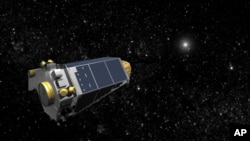The U.S. space agency NASA says it has found nearly 1,300 planets orbiting stars outside our solar system, and nine of those are orbiting at the right distance from their stars to sustain life.
NASA announced Tuesday that its Kepler space telescope has validated 1,284 planets among 4,300 potential planets identified by a new statistical analysis of possible planets in space.
Paul Hertz, NASA's director of astrophysics, said the research is important to help scientists figure out if there is life on other planets. "This gives us hope that somewhere out there, around a star much like ours, we can eventually discover another Earth," he said.
And why look for Earth-like planets?
"Engaging in this process of discovery with each other changes us in a very fundamental way," said Natalie Batalha, Kepler mission scientist at NASA's Ames Research Center in California.
She says she believes looking at what's beyond our own planet helps human beings appreciate their own lives and the planet Earth itself. She says it even helps people empathize better with other people.
Batalha notes that the first photo of Earth taken from the moon enabled people to see beyond national borders and imagine the planet and its population as a whole.
While one image can alter many perceptions, Tuesday's announcement shows how one big picture can emerge from thousands of pieces of data. While scientists usually evaluate potential planets one at a time, in this case researchers used a new statistical analysis method to evaluate thousands of candidates in Kepler's database for traits that would establish them as planets.
The analysis described Tuesday, led by Princeton University's Timothy Morton, involved tracking a planet's brightness for changes that would indicate it was orbiting its star, in the way that our Earth orbits the sun. The resulting data gave scientists a "planethood probability percentage" to help the experts focus on candidates most likely to turn out to be actual planets.
Traits for a planet
According to the International Astronomical Union (IAU), which voted on and approved the first scientific definition of a planet in August 2006, a candidate must have three traits in order to be classified as a planet. It must orbit its star, it must be big enough for gravity to squash it into a ball shape, and its gravitational pull must be strong enough to clear smaller objects out of the way of its orbit.
Among the likely planets, nearly 550 were found to be "rocky planets" somewhat like Earth, based on their size. Nine of those Earth-like planets were found to be orbiting their suns at a distance that would allow liquid water to pool, meaning they have conditions that would make life possible — at least the type of life that exists on Earth.
For decades, the idea of finding life on other planets has intrigued people on Earth. But lately, movies such as The Martian and Interstellar have focused not on meeting alien creatures, but on finding habitable environments for humans who have tapped out their resources on Earth.
Is that part of what these scientists are aiming for? Batalha says that, for now, she is focused on the search for life itself, rather than new homes for the human race.
"We have so many questions," she said. "Is DNA the only code that sustains life? How does life begin? Questions about the origin of life; why we're here."
And the latest planetary candidates are providing plenty of material to further the search.
"Before the Kepler space telescope launched, we did not know whether exoplanets were rare or common in the galaxy," said NASA's Hertz. "We now know there could be more planets than stars."
He says that information brings humans a little closer to finding out whether they are alone in the universe.
Does Batalha think there is life on other planets?
"Absolutely, no question," she said. "Why would we be the only ones?"
She references a quote from the movie Contact, attributed to astronomer Carl Sagan, that if humans were the only life in the universe, it would be "an awful waste of space."
Alone in the universe? The new numbers are making that idea look like science fiction.









